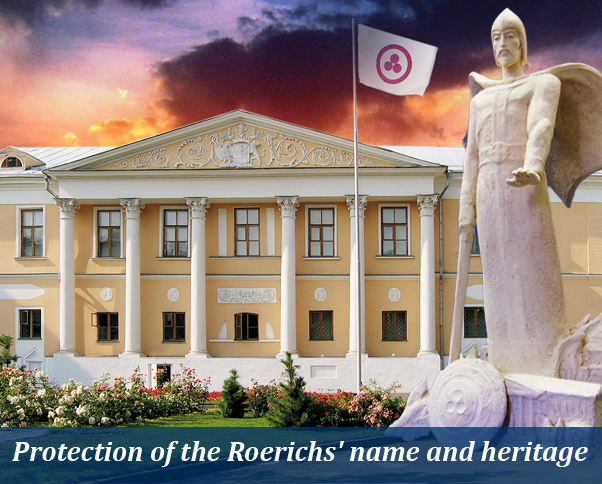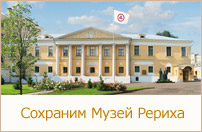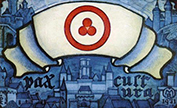 |
 |
 |
 |
In Protection of the Nongovermental Museum Named after Nicholas Roerich Read more >
"No Time To Dally!" ADDRESS OF THE NON-GOVERNMENTAL MUSEUM NAMED AFTER NICHOLAS ROERICH TO THE PEOPLE OF RUSSIA AND COMPATRIOTS ABROAD! Read more >
Donations to the Museum named after Roerich Read more >
In Protection of the Maecenas of the Nongovernmental Museum named after Nicholas Roerich B.I.Bulochnik Read more >
In Protection of the Living Ethics Read more >
The Roerichs' Heritage in India Read more >
Review of Dishonest Publications Read more >
The Roerichs’ Heritage Needs International Protection!
Resolution
The International Social and Scientific Conference
“75 years of the Roerich Pact”
І. Recalling the principles and norms of international law in the area of cultural property protection, in particular:
Considering that:
In accordance with the fundamental principle of international law, cultural property, historic monuments, museums, scientific, artistic, educational and cultural institutions form the cultural heritage of peoples without any discrimination as to the State allegiance of said property and institutions and their ownership[1].
The same fundamental principle firmly indicates that deterioration or disappearance of any item of the cultural heritage constitutes a harmful impoverishment of the heritage of all the nations of the world.[2]
Considering that:
Every country in whose territory there are components of protected cultural heritage has an obligation to safeguard this part of mankind's heritage and to ensure that it is handed down to future generations[3].
All cultural property forms part of the common cultural heritage of mankind and every State has a responsibility in this respect, not only towards its own nationals but also towards the international community as a whole.[4]
Considering that:
At present, the protection of this heritage at national level often remains incomplete and inadequate not only because of the scale of the resources which it requires and of the insufficient economic, scientific and technical resources of the country where the property to be protected is situated[5] but also – and this is extremely alarming – because of the flaws of the legal and judicial system of a given country which constitute an obstacle to ensuring the protection of the cultural heritage and of the human rights in the field of culture, because of negligence, carelessness, and disdainfor the cultural heritage by state authorities as well as because of intentional destruction by state authorities, including intentional failure to take appropriate measures to prohibit, prevent, stop, and punish any intentional destruction of such cultural heritage[6].
Considering that:
There is important international regulation and international mechanism of cultural heritage protection in cases when the country, where the heritage is situated, fails to protect and preserve it as a part of the cultural heritage of mankind, but which often is not applied.
In the cases mentioned above, protection at international level by way of an international legal mechanism is not only necessary but also an irreplaceable means of preserving such cultural heritage.
Considering that:
In accordance with generally recognized principles and norms, the rights of access to culture and participation in the cultural life are human rights[7], and their violation leads to abasement of human dignity and freedom; therefore, any such violation must be prevented by all means by all states, and it cannot be tolerated on the part of the public.
Cultural heritage protection is a precondition for the enjoyment of the right of access to culture and of participation in the cultural life.
International law establishes the principle that the protection of cultural heritage and the prevention of risks are much more important than compensation in the event of damage or loss, since the essential purpose is to preserve the cultural heritage, not to replace by sums of money objects which are irreplaceable[8].
There is no universal international legal mechanism for the protection of human rights in the field of culture.
International legal mechanism for protection of human rights in case of their violation operates in Europe in the event the possibilities of their protection at the national (domestic) level are exhausted. However, application of the said legal mechanism to human rights in the field of culture is quite problematic as sums of money cannot compensate and substitute for the cultural heritage, which is irreplaceable and by no means can such sums of money compensate for the deprivation of possibilities for creative activities[9], for the deprivation of possibilities of the future generation’s cultural development, and for the impoverishment of the cultural heritage of all the nations of the world[10].
Considering that:
The issues not fully covered by the international instruments concerning cultural heritage will continue to be governed by the principles of international law, the principles of humanity and the dictates of public conscience[11].
Considering that:
The principle of active public participation is one of the most important international law principles for cultural heritage protection expressed in the UNESCO instruments because “the surest guarantee for the preservation of cultural property rests in the respect and the attachment felt for it by the people themselves”[12].
The activity of the non-governmental organizations (local, national, and international) is one of the best ways to express public opinion and one of the best means of public participation in preservation of cultural property. Non-governmental organizations have often demonstrated their ability to preserve the cultural heritage as well as their being irreplaceable in this respect.
Considering that:
In accordance with the provisions of the UNESCO Constitution, peace should be based upon intellectual and moral solidarity of nations; therefore, solidarity of international and national non-governmental organizations is of vital importance for peace-keeping and cultural heritage protection.
The said solidarity of non-governmental organizations may become the most important part of the international mechanism capable of meeting the exigency of the cultural heritage protection when the actions on such heritage protection carried out by states are insufficient or inadequate due to the reasons specified above.
In accordance with international instruments in the field of culture, non-governmental organizations combining their efforts for the cultural heritage protection in the name of the future of mankind should obtain full support from the UNESCO member states as well as from UNESCO itself and other international intergovernmental organizations with proper competence in this area.
Noting that:
In accordance with Paragraph 2 (c), Art. I of the UNESCO Constitution, UNESCO is assigned the task of ensuring preservation, extension, and spread of knowledge while “assuring the conservation and protection of the world’s inheritance of books, works of art and monuments of history and science”.
ІІ. Recalling the universal importance of the Roerichs’ cultural heritage and the state of its preservation, namely:
Considering:
The paramount importance of the Roerichs’ artistic, scientific, philosophical and literary heritage for the world culture, its potential for uniting the nations in the name of culture as well as the deeply humanistic character of Roerichs’ ideas, and the substantial potential of this heritage for the development of natural sciences and humanities.
The important contribution of Nicholas Roerich in the establishment of the international legal system for cultural property protection by way of proposing the Treaty on the Protection of Artistic and Scientific Institutions and Historic Monuments (Roerich Pact) signed in the White House in Washington in 1935 and thus establishing the fundamental principles of such protection.
Setting the goal of preserving the Roerich family heritage for future generations.
Considering:
The dispersion of the Roerichs’ heritage in many countries of the world and the necessity for its thorough cataloguing, description, and registration for the purpose of securing the right of access to this world cultural heritage as well as for the purpose of preventing illegal trading of its parts[13] and ensuring the possibility of its international exchange.
Considering that in Russia:
The younger Roerich’s son Svetoslav Roerich – an Indian citizen, outstanding artist, thinker, and scientist – founded the International Center of the Roerichs in Moscow to which he made a will to give his parents’ heritage and did that in 1990. The International Centre of the Roerichs in fulfilling the will of Svetoslav Roerich established the public non-governmental Museum by name of Nicholas Roerich.
The International Center of the Roerichs embodies Roerichs’ ideas in its activity, it popularizes and develops the Roerichs’ heritage and therefore it serves as a space of freedom – freedom of thought, freedom of creation, and freedom of knowledge – which is extremely important for the revival of the genuine culture of the country wherein ideological control in the field of culture had existed for more than 70 years.
The creation of independent and free cultural space by the International Center of the Roerichs caused fierce counter-action by old established mechanisms. The International Centre of the Roerichs – a non-governmental international organization – has created a world class museum and has become a major cultural, scientific and spiritual centre, which propagates the ideas of peace and respect towards all cultures and instills in the general public and the youth deep respect for traditional knowledge of the peoples of the world and encourages its scientific research. In its activities the International Center of the Roerichs obtained neither economic, financial, legal, nor technical support on the part of the state authorities as is recommended by the UNESCO international instruments[14]. Moreover, the state authorities carried out actions which violated the fundamental principles of the said UNESCO international instruments and were aimed at cessation of the activity and closure of this “intellectual and cultural center”[15], which is undoubtedly a true definition of the International Center of the Roerichs and the established by it Museum by name of Nicholas Roerich.
The violation in Russia of the will of Svetoslav Roerich – the last member of the Roerich family – concerning the disposition of the Roerichs’ heritage, leads to the impossibility of exercising and, consequently, to the infringement of a number of rights, envisaged in the UNESCO Declaration of Principles of International Cultural Co-operation (Art. 1, Paragraphs 1 and 2; Art.4 , Paragraphs 1, 2, 3, 4; Art.7, Paragraphs 1 and 2, and others), as well as to infringement of the fundamental right – the right of access to world cultural heritage – to the Roerichs’ heritage.
In most difficult conditions during 20 years the International Center of the Roerichs has not only survived, but has grown into a major center of science, education, and culture, which has done all it can to preserve the Roerichs’ heritage in Russia. This serves as another impressive example of the extraordinary role of non-governmental organizations in the cultural heritage preservation, specifically during periods of profound economic and social transformations.
Noting that:
Ludmila Shaposhnikova, the first vice-president of the International Center of the Roerichs and the general director of the Museum by name of Nicholas K. Roerich, was awarded in 2010 the European Union Prize for Cultural Heritage / Europa Nostra Awards for cultural heritage preservation.
Noting:
Boris Bulochnik’s contribution to the revival of the best patronage traditions, since he is the selfless patron of the public non-governmental Museum by name of Nicholas K. Roerich of the International Center of the Roerichs. B. Bulochnik rendered assistance to the International Center of the Roerichs in the Museum establishment, in the reconstruction of the historical and cultural monument “The Manor of the Lopukhins” of the 17th-19th centuries, wherein the Museum is located, and in providing the Museum with everything necessary for its functioning. This involvement in the life of the non-governmental organization is related with certain hindrances from government civil servants the patron meets in his entrepreneurial activity and this makes his selfless support even more valuable and significant. Revival of these patronage traditions is very important for the future since it gives non-governmental cultural institutions the opportunity to perform their tasks of cultural heritage preservation in the absence of any assistance or support on the part of the state.
Noting that:
the International Center of the Roerichs and its Museum by name of Nicholas K.Roerich continue their work under conditions of no legal guarantees both for their existence and for the preservation of the Roerichs’ heritage bequeathed to them.
Expressing serious concern that for more than 50 years now there exists ambiguity with respect to the safety of the Roerichs’ heritage situated in Russia as well as threat of destruction of certain parts of that heritage.
Noting that:
the denigration and the slander of the Roerichs’ name and their creative heritage which are allowed in the Russian Federation lead to violation of the fundamental commitment specified in the UNESCO Declaration concerning the intentional destruction of cultural heritage (Art. 3, Paragraph 3), namely: “States should endeavour, by all appropriate means, to ensure respect for cultural heritage in society, particularly through educational, awareness-raising and information programmes”.
ADOPTS THE PRESENT APPEAL:
І. To international and national non-governmental organizations, calling them to:
1. Support the efforts of the International Non-Governmental Organization named International Center of the Roerichs directed at the preservation the Roerichs’ cultural heritage by way of establishment of a standing international committee consisting mainly of non-governmental organizations and public figures and aiming at the preservation of the Roerichs’ cultural heritage in the world.
2. For the organizations represented at the conference, namely: Europa Nostra – the pan-European federation of organizations active in the field of cultural heritage, the International Committee of the Red Cross, the Association of National Committees of the Blue Shield, the Austrian National Committee of the Blue Shield, the International Centre of the Roerichs, the All-Russian Society for the Preservation of Historical and Cultural Monuments – to support and assist in an Organizing Committee that would prepare the establishment of a Standing International Committee on Preservation of the Roerich’s Heritage in the World.
3. The support mentioned in Paragraph 1 can manifest itself in joining the Standing International Committee on Preservation of the Roerich’s Heritage in the World as well as in:
- Raising the issues, which are within the subject matter of this committee at all corresponding international fora so as to attract the world’s public attention to the problems of the cultural heritage protection when such protection is not sufficient at the national level;
- Providing support to the cause of preservation of the Roerich’s heritage in the world by means of information resources and technical assistance to websites, information bulletins, materials, etc.;
- The employment of all possible legal and cultural measures so that every state would become increasingly alert to the obligations to preserve the Roerich’s cultural heritage for the sake of all nations.
ІІ.1. To the international community and specifically to those countries wherein pieces of the Roerichs’ cultural heritage are located, including the Russian Federation, India, Bulgaria, and the USA, calling them to:
1. Strictly observe international law principles and norms specified in international conventions, as well as in the UNESCO recommendations and declarations.
2. Make comprehensive cataloguing and inventory of all cultural property (pieces of art, manuscripts, documents, publications as well as archive records) that forms part of the Roerichs’ cultural heritage and is situated within their territories and also ensure the preservation of the said cultural property and its inclusion in the national heritage list so as to:
§ Secure the right of access to the world cultural heritage – the Roerichs’ heritage – to their nationals and to people of all countries in the world;
§ Prevent illegal trading with the said cultural property;
§ Ensure the possibility for the international cultural exchange of cultural property – the Roerichs’ works.
3. Render full assistance to the Standing International Committee on Preservation of the Roerichs’ Heritage in the World and give its representatives full access to the information, to the documents related to this heritage, to the cultural property which is part of the Roerichs’ heritage, as well as any other assistance necessary for the implementation of its goals and tasks.
ІІ.2. To the Russian Federation in its capacity of UNESCO member state, calling it:
1. To respect the principles and norms of international law defined in the UNESCO instruments, as well as the human right of access to education and culture, and strictly implement Svetoslav Roerich’s will by way of completely handing over to the International Non-Governmental Organization named International Center of the Roerichs (ICR), established in Russia by Svetoslav Roerich’s wish and initiative, the bequeathed by him to the ICR Roerichs’ heritage.
2. To ensure that actions leading to the complete or partial destruction of the Roerichs’ cultural heritage situated in its territory, including the one which was brought to the Soviet Union by Yury Roerich, are avoided.
3. To take all the necessary actions for the preservation of the Roerichs’ heritage situated in its territory including the measures specified in Paragraph ІІ.1.2 above.
4. Not to allow further actions aimed at the destruction of the ICR, of the public Museum by name of Nicholas Roerich created by the ICR, as well as of the Roerichs’ cultural heritage preserved by the ICR, since these represent violations of the international principles and norms. The Russian Federation should create a stable legal basis for the ICR by means of corresponding legislative acts, which should ensure the integrity, the work and the development of the ICR.
5. Not to allow denigration or slander towards the Roerichs’ names and heritage and thus stop the violation of the international principles and norms established in the UNESCO instruments. The state should take all necessary measures in order to fulfill its international obligations, namely, to ensure respect for the Roerichs’ cultural heritage in society, particularly through educational, awareness-raising and information programmes.
The International Center of the Roerichs as a centre of world significance in the study, popularization, and preservation of the Roerichs’ heritage, and its Museum by name of Nicholas Roerich (Moscow) should be involved in the preparation of these programmes.
ІІІ. To UNESCO, calling it:
1. In accordance with the purposes and obligations provided for in its Constitution, to render by all available to it means full assistance and patronage to the Standing International Committee on Preservation of the Roerichs’ Cultural Heritage in the World as an efficient and real mechanism of international public control over the cultural heritage protection when such protection proves to be insufficient at national level.
[1] The 1935 Treaty on the Protection of Artistic and Scientific Institutions and Historic Monuments (Roerich Pact) Preamble, Art. 2; the 1954 Hague Convention for the Protection of Cultural Property in the Event of Armed Conflict, Preamble; the 2003 UNESCO Declaration Concerning the Intentional Destruction of Cultural Heritage, Preamble.
[2] The 1972 Convention Concerning the Protection of World Cultural and Natural Heritage, Preamble; the 1972 Recommendation Concerning the Protection, at National Level, of the Cultural and Natural Heritage, Preamble.
[3] The 1972 Recommendation Concerning the Protection, at National Level, of the Cultural and Natural Heritage, Preamble. See also: the 1970 Convention on the Means of Prohibiting and Preventing the Illicit Import, Export and Transfer of Ownership of Cultural Property, Preamble; the 1972 Convention Concerning the Protection of World Cultural and Natural Heritage, Art. 4.
[4] The 1976 Recommendation Concerning the International Exchange of Cultural Property, Art. 2; See also: the 1968 Recommendation Concerning the Preservation of Cultural Property Endangered by Public or Private Works, Preamble; the 1978 Recommendation for the Protection of Movable Cultural Property, Preamble.
[5] The 1972 Convention Concerning the Protection of World Cultural and Natural Heritage, Preamble.
[6]The 2003 UNESCO Declaration Concerning the Intentional Destruction of Cultural Heritage, Art.6.
[7] The 2001 UNESCO Universal Declaration on Cultural Diversity, Art.5; the 1976 UNESCO Recommendation on Participation by the People at Large in Cultural Life and their Contribution to It, Art.4 (а) and (b); the UNESCO Constitution; the UN Universal Declaration of Human Rights, Art. 27; International Covenant on Economic, Social and Cultural Rights, Art. 13 and 15; International Covenant on Civil and Political Rights.
[8] The 1978 UNESCO Recommendation for the Protection of Movable Cultural Property, Art. 9.
[9] The 1966 Declaration of the Principles of International Cultural Cooperation, Art.7, paragraph 1; the 1972 Recommendation Concerning the Protection, at National Level, of the Cultural and Natural Heritage, Preamble.
[10] The 1972 Convention Concerning the Protection of World Cultural and Natural Heritage, Preamble; the 1972 Recommendation Concerning the Protection, at National Level, of the Cultural and Natural Heritage, Preamble;
[11] The 2003 UNESCO Declaration Concerning the Intentional Destruction of Cultural Heritage, Preamble.
[12] The 1968 Recommendation Concerning the Preservation of Cultural Property Endangered by Public or Private Works, Preamble; See also: the 1978 Recommendation for the Protection of Movable Cultural Property, Art. 5, Art. 17; the 1972 Recommendation Concerning the Protection, at National Level, of the Cultural and Natural Heritage, Art.11, Art. 61; the 1972 Convention Concerning the Protection of World Cultural and Natural Heritage, Art. 27, paragraphs 1 and 2; the 1976 Recommendation Concerning the International Exchange of Cultural Property, Art. 11; the 1960 Recommendation Concerning the Most Effective Means of Rendering Museums Accessible to Everyone, Preamble, Art.2, Art.13, Art.14, Art. 16; the 1962 Recommendation Concerning the Safeguarding of the Beauty and Character of Landscapes and Sites, Preamble, Art. 37, Art. 40, Art. 42; the 1968 Recommendation Concerning the Preservation of Cultural Property Endangered by Public or Private Works, 1968, Art. 31, Art. 32; and other instruments.
[13] Legal import, export and transfer of ownership should comply with the 1970 Convention on the Means of Prohibiting and Preventing the Illicit Import, Export and Transfer of Ownership of Cultural Property, as well as with other relevant international instruments; and – in the events not completely regulated by international instruments – with the principles of international law, the principles of humanity and the dictates of public conscience.
[14] See: the 1960 Recommendation Concerning the Most Effective Means of Rendering Museums Accessible to Everyone, Preamble, Art. 3, Art. 17, Art. 18; the 1972 Recommendation Concerning the Protection, at National Level, of the Cultural and Natural Heritage, Art. 49, Art. 51; the 1989 Recommendation on the Safeguarding of Folklore, dated 15.11.1989, Art.D (d).
[15] See Article 13 of the 1960 Recommendation Concerning the Most Effective Means of Rendering Museums Accessible to Everyone: “Museums should serve as intellectual and cultural centers in their own localities. They should therefore contribute to the intellectual and cultural life of the community, which in turn should be given the opportunity of taking part in the activities and development of the museums”.
